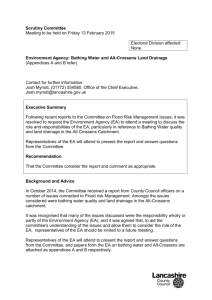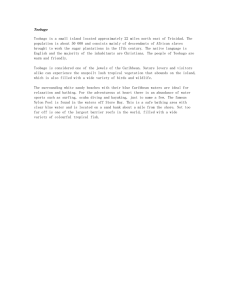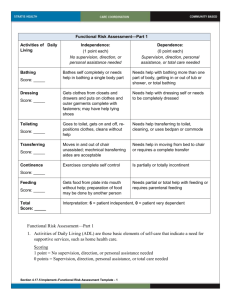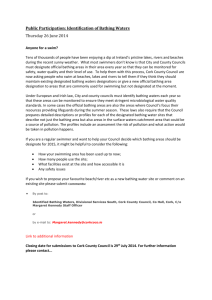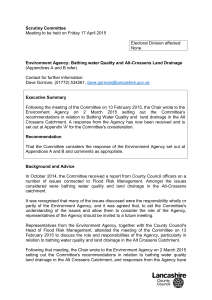RCRA Subpart BB - Air Emission Standards for Equipment Leaks
advertisement
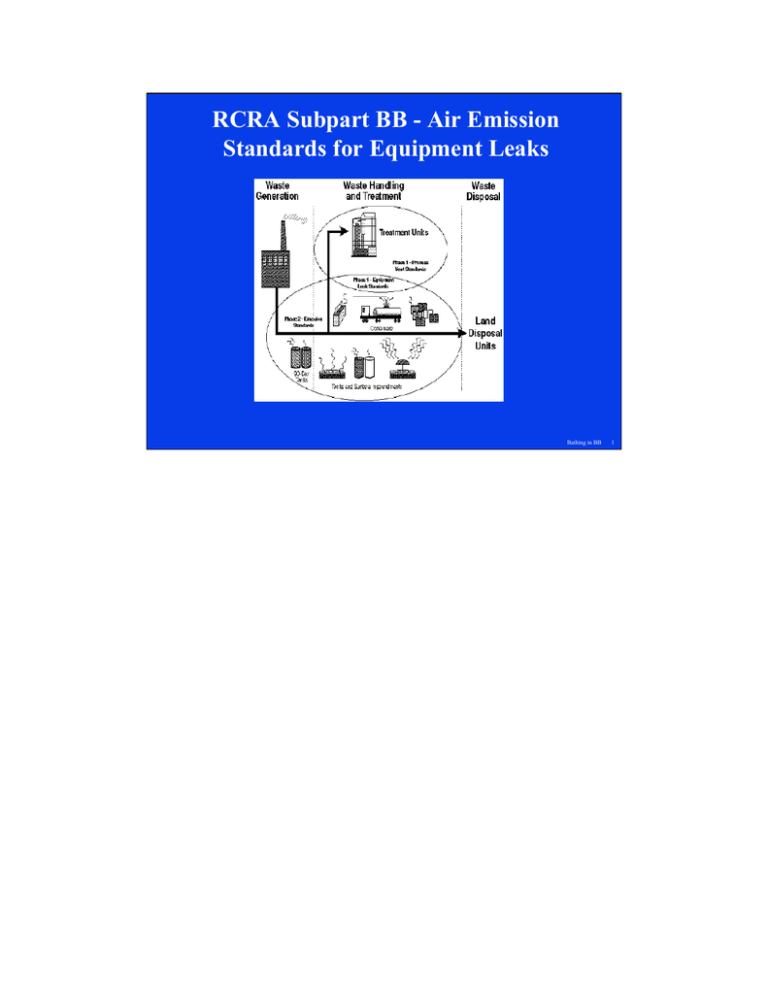
RCRA Subpart BB - Air Emission Standards for Equipment Leaks Bathing in BB 1 Equipment Regulated Under Subpart BB • Pumps • Compressors • Pressure relief devices • Sampling connection systems • Open-ended valves or lines • Valves • Flanges and other connectors Bathing in BB 2 Pumps to move liquids or sludges Compressors to move air Pressure relief devices to prevent overstress and blow out or structural failure Sampling connection systems Open-ended valves or lines - such as taps, sinks, drains, sumps, ends of transfer lines, chutes. Much more common than often thought. Valves - gate, ball, swing check, butterfly. May be manual operated or powerassisted. Flanges and other connectors - joints between pipe lengths or pipes and equipment. May be bolted, slip joint, compression, glued, screwed or welded. Applicability Issues for Subpart BB - Some Exemptions Exist for: • Equipment which contains or contacts hazardous waste < 300 hours per year, if cleaned at end of use [40 CFR §264.1064(g)(6), §265.1064(g)(6)] • Equipment in vacuum service [40 CFR §264.1064(g)(5), §265.1064(g)(5)] • Recycling units at 90-day generator facilities that are exempt under 40 CFR §261.6(c)(1) provided no other unit at the facility has to obtain a RCRA permit [40 CFR §264.1050(b)(2), §265.1050(b)(2)] Bathing in BB 3 Which Hazardous Waste Streams? • • Hazardous waste streams with organic concentrations of at least 10 percent by weight Gas or liquid at operating conditions • Liquid stream may be either a light or heavy liquid Bathing in BB 4 Subpart BB is applicable to all hazardous waste, unless specifically exempted. Air emission monitoring and control are required if these conditions are met, or there is uncertainty about the waste and the waste could potentially meet these conditions. In Subpart BB, Hazardous Waste Streams are Defined by Service • Light liquid service • • Heavy liquid service Gas/vapor service Bathing in BB 5 Determination of a Light/Heavy Liquid • Light liquid: – A liquid at operating conditions – Containing compound(s) with vapor pressure greater than 0.3 kPa at 20oC – Total concentration of pure components with vapor pressure greater than 0.3 kPa is 20 percent by weight or more • Heavy liquid – NOT light liquid or gas/vapor Bathing in BB 6 The definition of light liquid and heavy liquid is provided in 40 CFR §264.1031. 0.3 kPa is equivalent to 2.25 mm Hg. Presumption is made that a given waste stream is a light liquid, unless proven otherwise. Without analytical proof, a conservative approach must be assumed. Therefore, the more stringent requirements relating to light liquid service would apply. Monitoring Requirements (Slide 1 of 5) Equipment Pumps in light liquid service Frequency Monitoring Activity Weekly Visual check for evidence of potential leak (drips or staining) Monthly Instrument measure for leak determination (>10,000 ppm above background) Bathing in BB 7 Monitoring Requirements (Slide 2 of 5) Equipment Compressors Frequency Monitoring Activity Continuous Sensor system on seals and barrier fluids Daily Check on sensor system (unless sensor system uses audible alarm, then monthly check) Bathing in BB 8 Monitoring Requirements (Slide 3 of 5) Equipment Frequency Monitoring Activity Valves in Monthly gas/vapor or light liquid service Pressure relief devices in gas/vapor service Instrument measure for leak determination (>10,000 ppm above background) Within 5 Instrument measure for days after no detectable emission pressure (<500 ppm above relief event background) Bathing in BB 9 Monitoring Requirements (Slide 4 of 5) Equipment Frequency Monitoring Activity Sampling connections None Design and installation requirements Open-ended valves or pipes Operational Cap or plug when not in use, or use double valve system Bathing in BB 10 Monitoring Requirements (Slide 5 of 5) Equipment Frequency • Pumps in heavy No liquid service frequency • Valves in heavy stated liquid service • Flanges and connections • Pressure relief devices in light or heavy liquid service Monitoring Activity Incidental observation of potential leak • Visual method • Olfactory method • Audible method • Other method Bathing in BB 11 Closed Vent Systems and Control Devices can Obviate the Need for Monitoring • • • If the equipment is located in an enclosure vented to a control device, no monitoring is required Enclosure and control device must meet operational requirements [40 CFR §264.1033, §265.1033] Control devices same as required for Subpart CC – Carbon adsorbers/GAC and condensers – Boilers, incinerators & process heaters – Flares [40 CFR §264.1060, §265.1060] Bathing in BB 12 Applicability Issues for Subpart BB - Some Exemptions Exist for: • Ceramic, ceramic-lined or inaccessible connectors (including porcelain, glass and glass-lined connectors) are exempt from monitoring and recordkeeping requirements • Pumps with a dual mechanical seal system [40 CFR §264.1052 (d), §265.1052(d)] Bathing in BB 13 Repair Requirements • Leak must be repaired as soon as practicable – No later than 15 calendar days after detected – First attempt at a repair shall be made no later than 5 calendar days after detected • Repair attempts and outcomes require recordkeeping • Delays in repair have special requirements for recordkeeping and rationale [40 CFR §264.1059, §265.1059] Bathing in BB 14 Enforcement reality: If a regulatory inspection turns up a leak that has not been previously noticed by the facility (and there is a log entry to document that the facility has apparently been checking), the regulatory inspection becomes the date of first detection. This condition is true even if the leak appears to be significantly pre-exist the regulatory inspection. Subpart BB is not substantially punitive - the emphasis is on trying, as shown by inspection records and a monitoring program, not necessarily on succeeding. Note also that the repair requirements are general in nature, not specific to equipment type or service condition as are the monitoring requirements. Requirements for When a Leak is Detected • Identification (tag) must be attached to leaking equipment [40 CFR §264.1064(c), §265.1064(c)] – Weatherproof – Readily visible – Equipment identification number – Date potential leak was found – Date leak detected • ID tag may be removed after equipment is repaired – Except for valves, for which identification may be removed after 2 successive months without a leak being detected Bathing in BB 15 Recordkeeping Requirements - Operating Record of Facility • • • • • • • Equipment identification numbers Hazardous waste management unit identification numbers Approximate location of equipment (plot plan) Type of equipment Waste state and percent-by-weight total organics in waste stream at equipment Method of compliance with standard Control device efficiency or performance goal (if a control device is used) Bathing in BB 16 Note that EPA Region 4 requires that this information be included in the Part B permit application and Region 4 usually attaches this information to the permit as an appendix. Recordkeeping Requirements - Operating Record of Facility (cont’d) • • • • • • Documentation of waste analysis/determination of hazardous constituents Monitoring results and ID’s for units operated with no detectable emissions ID’s for units operated in vacuum service Documentation of service time and ID’s for units that contact hazardous waste less than 300 hrs/year Design criteria for compressor seal failure criteria and sensor performance Control device efficiency or performance goal (if a control device is used) Bathing in BB 17 Note that EPA Region 4 requires that this information be included in the Part B permit application and Region 4 usually attaches this information to the permit as an appendix. Recordkeeping Requirements - Inspection Log Kept in Operating Record • • • • • • • Leak measurement instrument, operator, and equipment identification numbers Date evidence was found of potential leak Date of actual leak detection Date of each repair attempt, methods used and outcome If repair delayed, reason, supporting documentation, signature of authorizing personnel, and expected date of successful repair Date of successful repair Inspection records must be kept for at least 3 years Bathing in BB 18 Reporting Requirements • Semi-annual report for – Valve, pump, or compressor leak not repaired as required – Dates of HWMU shutdowns – Control device exceedence(s) • Report broken down by month Bathing in BB 19 EPA Method 21 Overview • • Identifies leaks, does not quantify emissions Uses portable organic analyzers: – – – – • Flame ionization (FID) Catalytic combustion Photoionization (PID) Infra-red Specific operating procedures and calibrations are required – Instrument range and response – Daily calibration and pre-use checks – Response factor adjustment for specific organic compounds Bathing in BB 20 EPA Method 21 is found in 40 CFR Part 60. Correction factors for the compounds being monitored must be known and the results should be corrected during the inspection. FIDs are temperature sensitive and the ambient temperature during monitoring should be noted in the operating records for the monitoring event. Methods 21 should be done while equipment is operating to be most effective. The operating records should indicate that the equipment was in operation during the monitoring event. Application Photographs and Diagrams Bathing in BB 21 Bathing in BB 22 Flanged Joint Drawing Potential location of leak is joint between flanges. The monitoring required is for visual evidence of a leak, such as a drip or stain. Bathing in BB 23 Open-Ended Pipeline Drawing Open-ended or single valved pipelines include sinks, sumps, drains, and transfer lines. For leaks from a single valve pipeline, think of a dripping faucet (which has a ball valve) and scale up into other types of valves and applications. Also consider a floor drain beneath a process unit. Open-ended or single valved pipelines require caps, plugs or a double valve installation as an operational procedure for compliance with Subpart BB. Bathing in BB 24 Spring Loaded Relief Valve Drawing A movable piston or sealing disc responds to internal pressure. Subpart BB requires that the valve returns to a condition of no detectable emissions, defined as an emission that is less than 500 ppm above background, within 5 days of a pressure relief event. Key issue - how does a facility know when a pressure relief event has occurred? There is no standard in the regulations. It is an issue for design, what is an appropriate pressure for a relief event? Because of the 5-day time period requirement, the valve must close at least once within every 5 days. The onus is on the facility to prove that the valve actually closes, meaning that the facility must also document when the pressure relief event occurs. Hence, monitoring and recordkeeping is important. The answer often comes in the form of a control device, typically plumbing the vent stream to a carbon unit for vapor recovery. Bathing in BB 25 Rising Stem Gate Valve Drawing Note the location of moving parts with the valve stem and gate and the adjacent seals, which is where the leaks may occur. Reasons for leaks to occur are often related to improper tightening during installation. Note the packing gland, this is the feature for which the first attempt to repair is made. The packing gland is tightened, similar to what would be done for a dripping faucet. If tightening the packing gland doesn’t work, the seals are typical replaced (again, just like a dripping faucet in a home). There is a lot of concern in the regulations about failing valves and the lack of success in repairs, so several months of repeat inspections are required to approve a repair. Bathing in BB 26 Photo - Cut Away of Gate Valve Upper orange fitting is seal, which is the location of greatest concern. However, there should also be concern for the match of the valve body with the adjacent piping. Bathing in BB 27 Photo - Power Actuated Ball Valve The moving parts all will be related to the shaft of the stem. Do not worry about the drive apparatus, only the flange connections and seals around the hydraulic part of the valve. Bathing in BB 28 Centrifugal Pump Section Drawing See the location of the suction throat, impeller, seal and shaft. The potential leak areas are the seal and shaft assemblies, and the flanged connections. Bathing in BB 29 Centrifugal Pump Photo See the red arrow for the potential leak location related to the pump seals. Other potential leak locations exist in the photo related to the flanged connections above the pump. Useful Web Sites (recommended as examples, not officially endorsed) • http://www.gouldspumps.com – Technews /Pump Fundamentals /Pump Application Guide • http:// www.redwhitevalveusa.com – Technical Observations - valve failures • http://air.ingersoll-rand.com – Air System Information - compressors Bathing in BB 30
